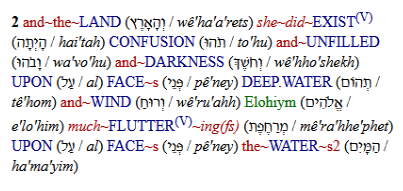


 |   |
| Home | Articles | Translation | | | Bookstore | AHRC | AHLB |
 By Jeff A. Benner
The Mechanical Translation of the Hebrew Bible project began in 2005 with the publication of my Ancient Hebrew Lexicon of the Bible. This lexicon laid the foundation for a translation of the Hebrew Bible where each word would be translated faithfully according to its original linguistic and cultural perspective. My vision of this translation included a translation that;
To better understand the philosophies and methodologies of this translational project, let's take a closer look at each of the points above.
It has been argued that it is impossible to eliminate bias into any translation, especially one of a religious nature. However, I have developed a method that almost completely removes the possibility of any personal or religious bias within the translation. This is achieved through a two-fold process. The first process is through the Lexicon. Each translation and definition of each word in the lexicon is chosen based primarily on its etymology (what is the words meaning based on its relationship to other words and roots), context (how is the word used throughout the Bible) and culture (What did the word mean to those who lived within that culture). The second part of the process simply involves replacing the Hebrew word, prefix or suffix with its corresponding English word from the Lexicon. This method of translation also has the unique quality that if the reader disagrees with the translation of a Hebrew word, he can simply replace that word with his own and as the translation is accompanied with a concordance, finding the location of each occurrence of that word is fairly simple. 2. A word for word translation Every translation to date, including interlinears and literal translations, translates the Hebrew text according to context. The problem with this is that the context can be interpreted differently based upon the translators' personal opinions of what that context is. In contrast, a word for word, prefix for prefix and suffix for suffix translation is very mechanical and prevents the translator from "fixing" the text. One advantage to this method of translation is that the reader is able to see the text in its pure and original Hebrew format. However, there is one major drawback to this method of translation. Hebrew syntax (sentence structure and style) is very different from English syntax and a reader that has no background in Hebrew syntax would be completely lost in the translation. To alleviate this problem, the "mechanical" translation is accompanied with a "revised mechanical" translation. 3. Easily read and understood The "revised mechanical" translation re-arranges the words of the "mechanical" translation into more readable and understandable English syntax. This method of translation is common among other translations but the changes are invisible to the reader. With the "mechanical" and "revised mechanical" translations side by side, the reader is able to see the changes that are made. There are times when the "revised mechanical" translation is difficult to read and may not make perfect sense, but this is due to the fact that the Hebrew structure of a given sentence is sometimes difficult to read itself. While most other translations "fix" the text so that it will always be read easily, this translation preserves the difficulties. It is the opinion of the author of this translation, that those who will be interested in this translation, will be willing to put in the extra effort to understand a difficult passage. 4. A dictionary and concordance No one English word can fully convey the meaning of one Hebrew word. For this reason, the translation will include a dictionary that will more finely define each word within its linguistic, contextual and cultural setting. In addition, for in-depth study of the words in the Bible, a concordance will be included that will identify the location of each word within the text. 5. A tool for learning Hebrew Learning Hebrew is much more than memorizing the meaning of Hebrew words. It involves learning to recognize prefixes and suffixes attached to a word (common Hebrew, much more so than English), verb conjugations (which include subject, tense, gender, number, mood, voice and sometimes the object of the verb) and syntax. When reading the Hebrew text of the Bible, the reader will come across words which will be difficult to decipher. The reader can check the "mechanical" translation to help assist with deciphering the word. The reader is also able to check the "revised mechanical" translation if he is unable to determine the meaning of the sentence itself.
|